
Welcome to the Riverside Park Tree Walk in Moline, Illinois—a self-directed journey through the beauty and diversity of our local trees. As you stroll through the park, scan the QR codes located at the entry pathways to discover detailed information including each tree's common and Latin names, growth habits, seasonal features, and more. This self-guided walk is designed to help visitors appreciate the natural landscape, learn to identify tree species, and gather ideas for selecting trees suitable for home landscapes. Brought to you by the Rock Island County Master Gardeners of the University of Illinois Extension, this project combines education, conservation, and outdoor enjoyment for all ages.
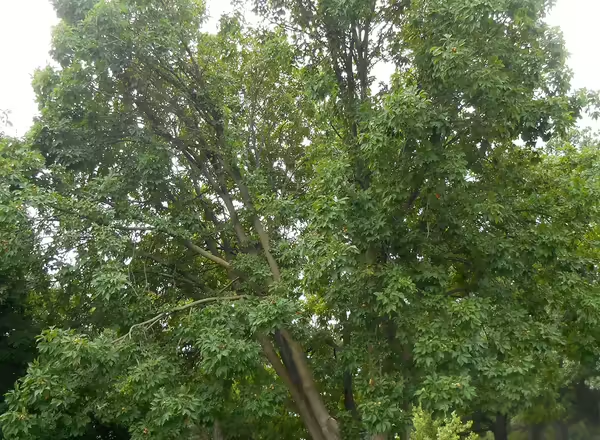
(Aesculus glabra)
The “buckeye” in the name is because the fruits are mahogany brown with a large gray spot that resembles a buck's eye. Ohio buckeye is also called stinking or fetid buckeye because the leaves and twigs give off a skunk-like odor when crushed.
Size: 30-50' high (80' possible)
Habit: Mostly oval, but can be rounded
What to look for:
- Bears 5-7 finely serrate leaves in a palm shape.
- Flowers are greenish-yellow and form large, 4-7" upright panicles in early to mid-May. The 1-2" spiny fruits contain seeds that are toxic to humans.
- Fall color ranges from yellow to orange, or reddish-brown and develops early in fall.
Of interest:
- Leaf blotch, powdery mildew, bagworm and scales (among other issues) can make this tree look ratty in late summer.
- It is best used in native habitat restorations rather than in the residential landscape.
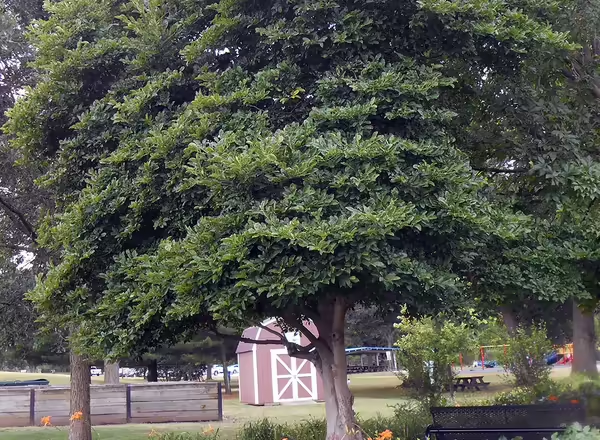
(Magnolia)
The Magnolia genus is a group of approximately 240 species of trees and large shrubs. The Magnoliaceae family can be found in fossil remains dating between 36 and 58 million years ago. Surviving magnolia species follow the traits of their primitive relatives with flowers composed of petal-like tepals, instead of petals and sepals. The flowers do not produce nectar, instead secreting a fragrant, sugary substance to attract pollinating beetles. Because magnolias evolved long before bees and other flying pollinators, the beetle’s primitive relatives were the primary pollinators of magnolia flowers.
They like moist, acidic, organic soils and grow in temperate and tropical climates. They may be both evergreen and deciduous.
Size: 20-30' high
Habit: Low branching slightly
What to look for:
- Leaf size can range from 2" long and 1" wide (star magnolia) to 10" long and 4" wide (Southern magnolia). They are usually dark, lustrous green on the upper side, but may be light green, fuzzy reddish-brown, or even silvery on the lower side. The leaves are arranged in an alternate fashion on the stems.
- They have showy, fragrant flowers that can be white, pink, red, purple, or yellow; followed by red or pink fruits with red, orange, or pink seeds that each hang from the fruit by a thread-like strand.
Of interest:
- Not all magnolias are hardy in Northern Illinois.
- The main insect pest in Illinois is magnolia scale which affects nearly all magnolias. These insects feed on the tree’s sap, affecting the health of the tree, and can lead to the death of the tree.
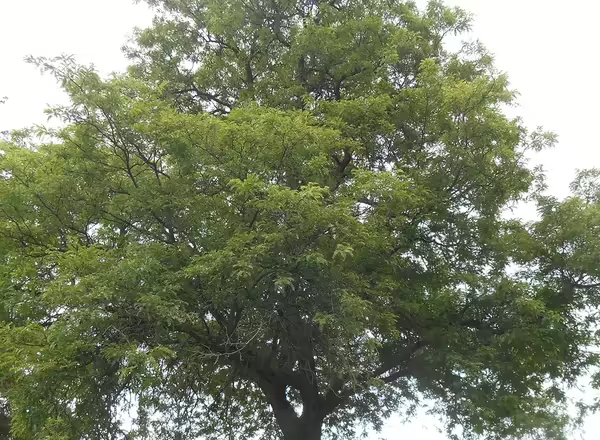
(Gleditsia triacanthos)
The honeylocust is a deciduous native tree that bears long branched thorns that are quite hazardous; however, most current selections are thornless and fruitless as well.
Size: 50-70' high
Habit: Rounded to wide-rounded
What to look for:
- Unless thornless, it bears thorns that can be up to 12-18" long and multi-branched.
- Greenish-yellow flowers in May to June are fragrant with lots of nectar. Unless fruitless, it produces 7-18" long dark reddish-brown to brown pods that are often twisted.
- Leaves usually turn clear to golden yellow and fall in early autumn.
Of interest:
- Easy to transplant
- Tolerates a wide range of soils
- Pollution and salt spray tolerant
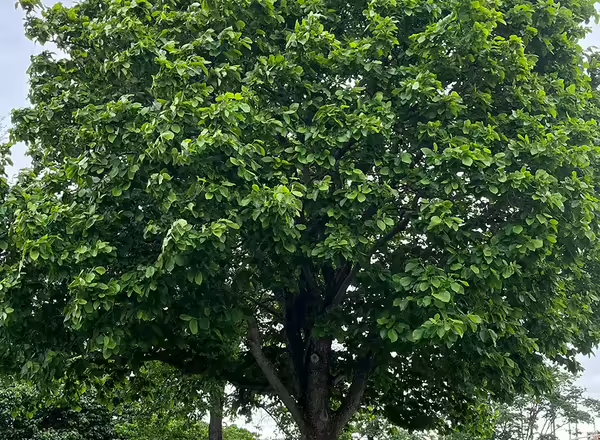
(Magnolia x 'Elizabeth')
Elizabeth Magnolia is a cross between magnolias P. acuminata × M. denudate. It was developed in 1956 by Evamaria Sperber of the Brooklyn Botanic Garden, and named and patented (PP 4145) in 1977; after Elizabeth van Brunt, a Director and benefactor of the Garden.
Size: 15-40' high
Habit: Pyramidal to rounded-pyramidal
What to look for:
- Leaves are green, 4-8" long, alternately arranged, and obovate in shape.
- Flower buds are tapered and open to primrose-yellow blooms which appear before the leaves. The plant patent states that the petals are "clear yellow with the outermost whorl slightly tinged with green." The flowers are pleasantly fragrant and sterile.
- The tree rarely fruits; however, if it does, the fruits are red with a dry or hard cover.
- Fall color is a not-showy yellow.
Of interest:
- There are actually two clones cultivated under the name of 'Elizabeth', and that the incorrect clone may be the more common.
- Apparently location affects the flower’s color. In the Pacific Northwest, 'Elizabeth's’ luminous yellow flower rapidly degrades to a cold, creamy or greenish white. In the South of England, the flower is creamy yellow. Under the strong light of South Korea and New Zealand, the flower is an intense yellow color.
- ‘Elizabeth’ is susceptible to Botrytis, which stains the petals a dirty brown.
photo credit: Dick Potter
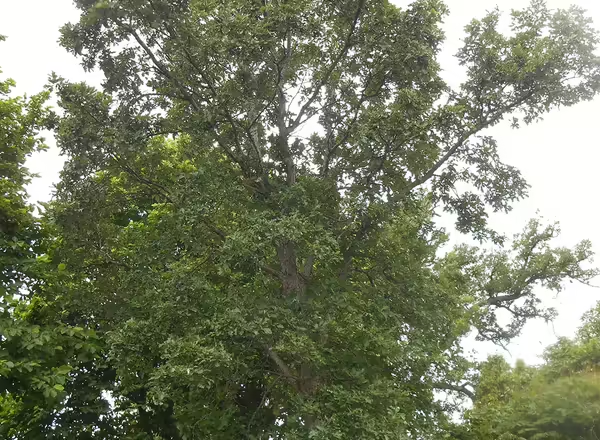
(Quercus bicolor)
Swamp white oak makes an excellent large shade tree in either wet or dry sites. Because of its tolerance of poorly drained sites, it is most often high on the list of plants for such sites. Because of its size, it is best suited to large sites.
Size: 50-60 ft tall
Habit: Rounded to broad-rounded with wide-angled, open branches.
What to look for:
- The leaves are thick and stiff with a dark, shiny green upper surface and whitish, velvety pubescent undersides. The white contrasts nicely with the dark upper sides giving the name “bicolor.”
- The acorns are 1-1.5" long with a cap that covers 1/3 of the nut. The nuts are sweet and nutritionally important for duck, turkey, songbirds, squirrel, mice, and deer. Large crops are produced every 3-5 years.
Of interest:
- The contrasting colors of the leaves are easily visible from a distance in the wind.
- It is commonly seen in poorly drained bottomlands and stream banks, but is also an excellent shade tree in drier sites. It does need acidic soils.
- It is rapidly growing and long lived, up to 300-350 years.
- The wood is hard, heavy and strong. It is used as a fuel and in building cabinets, interior finishing and fence posts.
- The Iroquois used it to treat cholera, broken bones and tuberculosis.
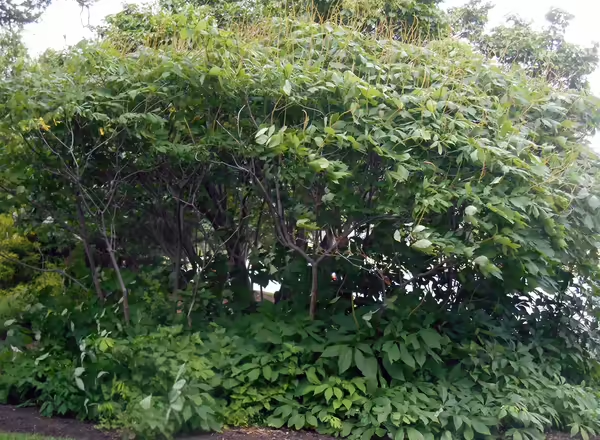
(Aesculus parviflora)
Brown seeds each with a pale scar that looks like a "buck's eye" contributed buckeye to it’s name. Summer flowering attracts hummingbirds, butterflies, and pollinators.
Size: 8-12' high
Habit: Wide-spreading, suckering
What to look for:
- Bears 5 (sometimes 7) compound leaves in a palm shape.
- Flowers appear in July, and rise above the foliage in white to slightly pinkish-white 8-12" panicles.
- Smooth grayish-green, 1 to 1.5" capsules mature and release shiny brown seeds in early fall.
- Fall color is yellowish bronze or yellow-green.
Of interest:
- Upside: An excellent summer flowering species, since little else flowers as prolifically in sun or shade.
- Downside: Every part of this tree is highly toxic to humans if ingested.
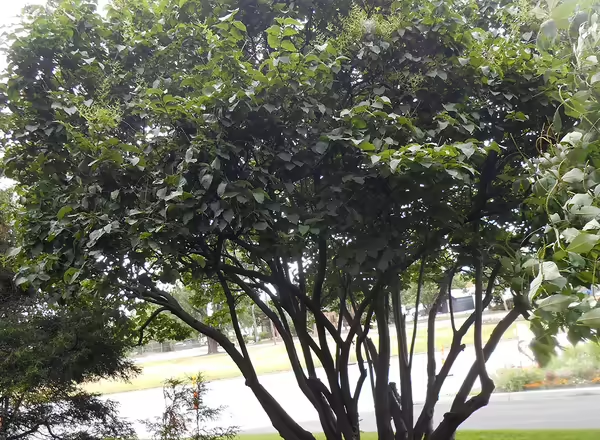
(Syringa reticulata)
Japanese tree lilac was introduced into cultivation in 1876. Syringa is from the Greek syrinx, which means “pipe” and refers to the hollow stems; reticulata means “netted” or “net-veined” and refers to the leaf venation.
Size: 20-30'
Habit: This is a large shrub to small tree with spreading branches, forming an oval to rounded crown.
What to look for:
- Leaves are dark green above and a grayish-green below.
- Flowers are 6-12" white, fragrant panicles appearing in early to mid-June.
- The fruit is a 3/4" long split capsule.
- Fall color is a greenish-yellow.
Of interest:
- Japanese tree lilac is native to northern Japan. Syringa has about 30 species of trees and shrubs native to Europe and Asia, but the Japanese tree lilac is the only species that attains a tree-like form and size.
- Japanese tree lilac adapts well to difficult or urban sites, and is the most trouble-free lilac.
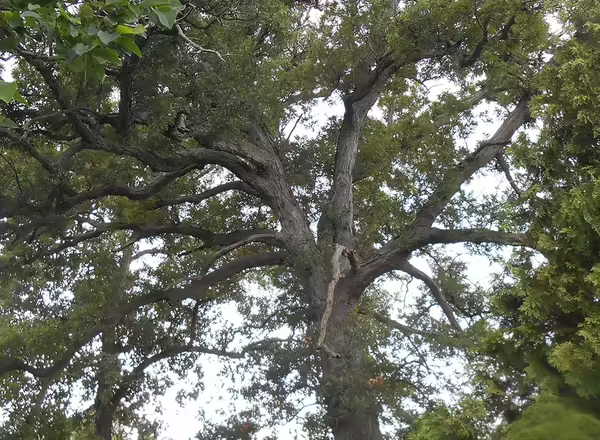
(Quercus alba)
The white oak is the official Illinois state tree, and occurs in every county in Illinois. This tree has a very long tap-root, so know your yard, trust your nursery, and do the research before investing in one.
Size: 50-80' high
Habit: Pyramidal in youth becoming rounded to broad-rounded and picturesque due to bold, coarse, wide branching.
What to look for:
- The top of the leaf is a rich dark green with a pale green underside, and 5-9 deep cut rounded lobes.
- The tree bears 2-3" long, yellow-green male flowers (catkiins) and small, insignificant, green female flowers on the same tree.
- The brown acorns, appearing when the tree is about 20 years old, are 1/2 to 3/4" long with a warty cup that covers 1/4 of the acorn. Prized by wildlife, acorns are edible with a sweet taste.
- In late fall, the leaves turn bright red to a deep red or red-brown. The color can last for many weeks.
Of interest:
- White oak is used for everything from fine furniture to whiskey barrels; however, it is being replaced by several species of eastern red oak, which grow faster and are easier to treat with preservatives.
- Native Americans used white oak to treat ailments; i.e., diarrhea, mouth sores, asthma, and coughs. Sadly, the spongy moth feeds on white oak and has killed many of them over the last few decades.

(Malus floribunda)
The flowering crabapple is native to Japan and often referred to as the Japanese crabapple tree. It produces one of the best flowering displays in mid-spring of any of the crabapples--making it an excellent lawn or street tree. Make sure to give it space to spread, and not too close to buildings or roads.
Size: 12-25' high
Habit: Broad-rounded, picturesque, wide bold branching with unusual angles, open with old age.
What to look for:
- Leaves are alternate, simple, elliptic-ovate, and 1 1/2 - 3" long.
- Fragrant flowers start as red buds that open to a delicate light pink color that fades to white.
- The fruits are small 1/4 - 5/16" pomes that yellow at maturity, with a reddish blush toward the sunlight. The fruits are well liked by birds.
- Fall color is a poor yellow-green.
Of interest:
- There are 20 - 30 species of crabapples growing in temperate regions of North America, Europe, and Asia.
- Crabapples tend to be cross-fertile and freely hybridize.
- There are approximately 800 crabapple types.
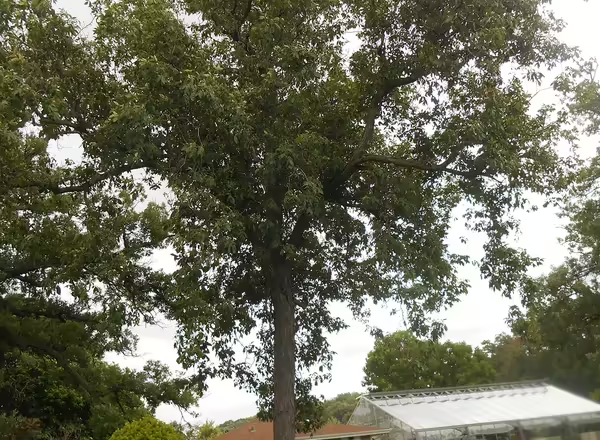
(Carya ovata)
The shagbark hickory is most easily recognized by its bark, which is light gray, fissured, and peels off in long, curling strips when the trunk reaches 4 to 8 inches in diameter, giving the tree a "shaggy" appearance.
Size: 60-80' high
Habit: Oval to slightly irregular with open areas in the crown.
What to look for:
- The leaves are alternate and pinnately compound with 5 oblong leaflets.
- Male and female flowers appear on the same tree (monoecious) in late April to early May. Male flowers are yellow-green 4-5" catkins and the females are small and clustered 2-5 together on spikes.
- The fruit is a 1-2" diameter nut enclosed in a 4-valved casing that splits away into four equal quarters. Hickory nuts are valued by both wildlife and people. In the fall leaves change to a beautiful yellow or golden-brown.
Of interest:
- Tool handles and athletic goods are made of hickory wood because it is strong and has a high shock resistance. It’s also used to smoke meats.
- Trees begin producing seeds at about 10 years old, but large quantities are not produced until 40 years and will continue for at least 100. Nut production, however, is erratic with good crops every 3 to 5 years, in between which few or no nuts appear.
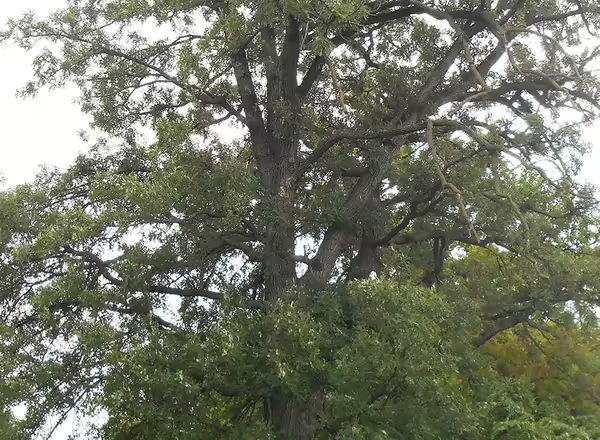
(Quercus macrocarpa)
Bur Oak is also referred to as mossy-cup oak It is the most fire-resistant of the oaks due to its thick bark. Its deep taproot allows it to survive drought, and it is one of the most cold-tolerant oaks.
Size: 70-80' high
Habit: Pyramidal in youth becoming broad-rounded with wide branch angles and bold coarse branching; picturesque.
What to look for:
- The leaves are 5-10" long, coarse, and often fiddle shaped due to a deep middle sinus.
- Male and female flowers appear on the same tree (monoecious) in April. Male flowers are yellow-green catkins and the females are small, inconspicuous, and reddish.
- The fruits are 1-2" diameter acorns that bear a distinctive fringed cap that covers 1/2 to 3/4 the length of the acorn. The fruit matures in the first year.
- Fall color is often only yellow-green, however, it can occasionally be a good yellow or yellow-brown.
Of interest:
- The tree is slow growing, but long lived, and may reach ages approaching 1000 years.
- Bur oak wood is durable and of high quality. It is used for cabinetry, barrels, hardwood flooring and fence posts.
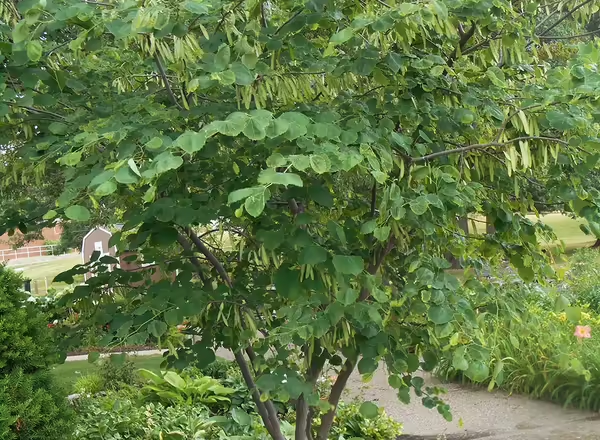
(Cercis canadensis)
Also known as the Judas-tree, the eastern redbud was introduced into cultivation in 1641. George Washington reportedly transplanted redbuds from the woods to his Mount Vernon gardens in Virginia.
Size: 20-35'
Habit: Small, rounded to broad-rounded, flat-topped tree, often with the trunk divided near the ground.
What to look for:
- Leaves are alternate, simple, broadly heart-shaped, and 3-5" high and wide. Leaves emerge reddish and turn green as they expand.
- Flowers are magenta-pink, appear in mid-to-late April before the leaves, and last up to 3 weeks.
- The fruits are 2-3" long, flat pods that emerge reddish-purple, then become green, and finally brown. They remain through the winter.
- In autumn, fall coloration ranges from yellow to yellow-green, with variable degrees of showiness.
Of interest:
- Redbud flowers and young legumes are edible. Fruits ripen in October.
- This tree will grow 7-10' in 5-6 years.
- The branches and stems have been used for basketry.
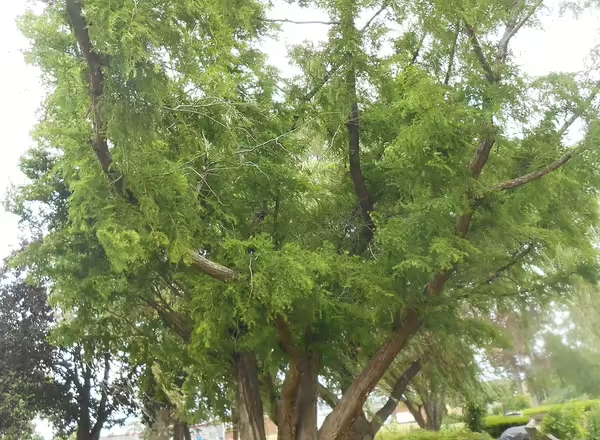
(Metasequoia glyptostroboides)
A fast growing conifer with soft, feathery light green deciduous foliage borne in mostly opposite branchlets. This species is believed to have been in existence for over 50 million years. It was thought to be extinct, but was discovered during a plant expedition into remote China in the 1940s.
Size: 70-100 ft tall, the shortest of the Redwoods. Habit: Conical to narrow pyramidal and formal with a single straight trunk that tapers from the buttressed base to the narrow apex.
What to look for:
- The deciduous leaves are linear, opposite, flat, and light green above and underneath. They are soft to the touch and 1/2 - 1" long.
- Light green in summer changing to a rusty, orangish-brown in fall.
- The leaves are attached to flattened branchlets which fall as a unit in autumn.
- The cones are round to slightly oval in shape and 3/4-1 1/4" in diameter. Pendulous and on long stalks, they are dark brown in color and mature in the first year. The seeds are small.
Of interest:
- There are few disease and insect problems.
- It is a very graceful tree that can be used as a single specimen in the lawn or in group plantings.
- Easily transplanted.
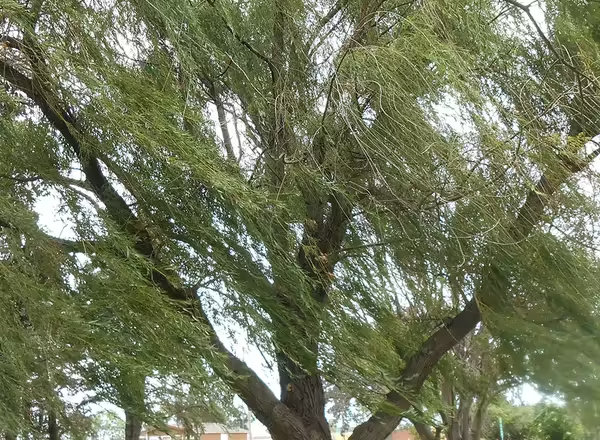
(Salix alba)
Weeping willow trees are often found in extremely wet sites. This fast-growing species is good in moist areas where little else will thrive. The white willow is a species of willow native to Europe and western and central Asia. The name derives from the white tone to the undersides of the leaves, due to fine, silky, silvery-white hairs.
Size: 75-90 ft tall
Habit: Large deciduous tree with graceful open crown of pendulous, brilliant yellow twigs that can touch the ground.
What to look for:
- It has narrow finely toothed bright green to dark green leaves that turn golden-yellow in the fall.
- It is dioecious, with male and female trees, each having separate type flowers in showy catkins.
- The fruit is a simple, valved capsule that splits to release silky, wind-carried seeds.
Of interest:
- Highly adaptable to all kinds of soils, but prefers sunny, moist locations.
- Be careful to not plant near septic fields or sewer pipes as roots will invade these areas looking for the moisture.
- Can be propagated by breaking off branches and sticking them in moist ground.

(Platanus occidentalis)
Also known as the American sycamore - it is best recognized by its stately, creamy-white, exfoliating bark. It is a species of Platanus, native to the eastern and central United States, the mountains of northeastern Mexico, extreme southern Ontario, and possibly Quebec. It is a common tree and one of the largest in the eastern deciduous forests.
Size: 75-100 ft tall
Habit: Oval to rounded, open with a massive crown. Has crooked branching.
What to look for:
- Striking, exfoliating bark. The bark is rigid and breaks off easily with growth leaving a smooth white area showing.
- Rounded fruit persists through winter.
- Leaves are broader than long.
Of interest:
- It is fast-growing and long-lived, surviving at least 200 years and likely as long as 500–600 years.
- It tends to be messy, often dropping limbs and large leaves, presenting constant maintenance.
- Grows to a larger trunk diameter than any other native hardwood.
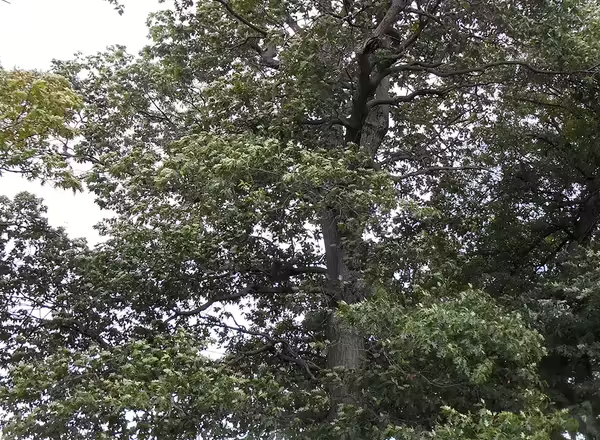
(Quercus rubra)
One of the most popular of the oaks, this large, deciduous native tree makes an excellent large shade tree for large landscapes, parks, and golf courses and is a common street tree. The combination of its transplantability, clean foliage, good fall color, and fast growth rate in youth makes this a popular choice.
Size: 60-75 ft tall
Habit: Pyramidal in youth, becoming rounded to broad-rounded.
What to look for:
- The 5 to 8" long leaves have 3-11 bristle-pointed lobes. They are glossy dark green on top and paler below with tufts of hairs in the axils of the veins.
- As fall approaches, the petioles pick up a slight to strong red cast where exposed to sunlight.
- The shiny and glabrous stems are greenish-brown turning reddish-brown.
- The 3/4 to 1" long acorns have shallow caps on the previous season's growth, as they take 2 years to mature.
Of interest:
- Northern red oak is a Midwest native and is one of the faster growing oaks for the home landscape.
- Potentially good but variable, the fall color ranges from a russet-red (most common) to occasionally bright red, but sometimes a poor yellow-brown.
- Its tolerance of salt and air pollution makes it a good tree for more exposed areas.
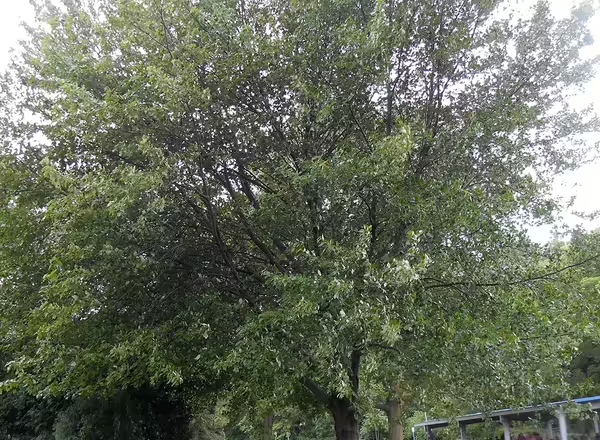
(Acer rubrum)
The red maple is also referred to as scarlet maple, Drummond's red maple, swamp maple, soft maple, and water maple. The red maple was officially adopted as the state tree of Rhode Island in 1964.
Size: 40-60' high
Habit: Pyramidal in youth, becoming uniform oval to rounded.
What to look for:
- The leaves are 2-5" long with 3-5 lobes, and are dark glossy green above with a light grayish-green underside.
- Red maples produce dense clusters of red to reddish-yellow flowers in March before the foliage. Flowers of this species are polygamo-dioecious (having bisexual and male flowers on some trees, and bisexual and female flowers on others).
- The bright red, immature winged fruits are somewhat showy 2-4 weeks after flowering, and mature to a brown or reddish-brown.
- Fall colors range from excellent reds, oranges, and yellows, and poor yellow-green.
Of interest:
- Red maples can grow in swamps and on dry ridge tops. During early root development on wet sites roots extend and branch outward, while on drier sites a deeper tap root forms with fewer lateral branches.
- It is considered a soft maple with the wood being used for furniture and gun-stocks.
- The sugar maple is the biggest syrup producer; but the red maple is also used to make maple syrup.
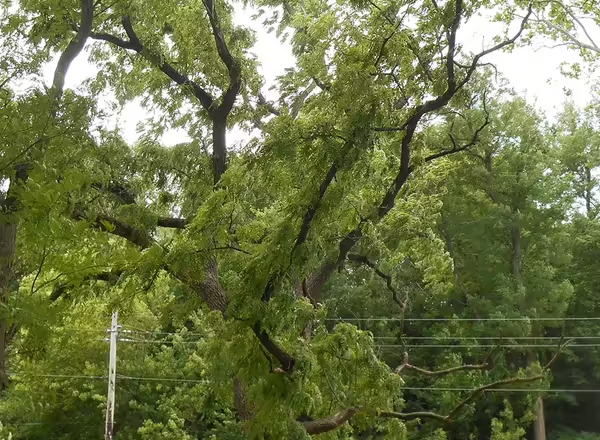
(Juglans nigra)
A beautiful, large, native tree, the black walnut is one of the last trees to leaf out and one of the first to lose its leaves. It is a highly prized native species in the woodworking industry, being used for the manufacture of furniture and gun stocks. The edible nut is known as very tasty or very bitter, depending on the person’s preference. It is especially popular to eat when made into a paste with honey or added to brownies..
Size: 75-100 ft tall; up to 150 ft.
Habit: Rounded, with sparse branching, lower branches become pendulous and droop downward, nearly touching the ground.
What to look for:
- The 12-24" alternate, pinnately compound leaves each bear 15-23 serrulate leaflets, terminating either singly or in pairs.
- Mature leaflets exude a pungent odor when crushed.
- Although technically a drupe, the fruits of this tree contain a hard-shelled nut surrounded by a thick slightly fleshy husk. The fruits are commonly referred to as a nut and are 1.5" in diameter.
Of interest:
- The nuts are encased within a 2-2.5" sticky green husk that contains juices that turn brown to black when exposed to air. The juice will stain anything it touches black. This often makes nut collecting rather messy and difficult, but the edible nutmeat is well worth the effort.
- Fall leaves drop very early, and the color is a poor yellow to yellow-green.
- This species is allelopathic in nature, secreting a chemical known as juglone through all portions of the plant, killing most plants that grow around it.
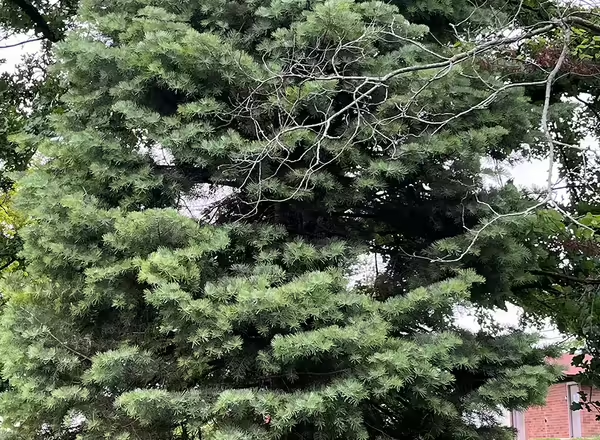
(Abies concolor)
White fir is a hardy, ornamental, native North American evergreen. It is a slow-growing, evergreen which makes an excellent landscape plant with its long, silvery, blue-green pale needles. Being more tolerant than most firs, it is most adaptive to adverse conditions in the Midwest.
Size: 30-50 ft tall
Habit: Densely wide conical to narrow pyramidal with a straight central leader, the upper branches point upward while the lower branches are more horizontal or deflected downward.
What to look for:
- The flowers are monoecious and inconspicuous like those of other firs. Oblong to cylindrical, 1 - 1.5" long, and red to rosy in color.
- The cones are 3-6" long, cylindrical and are borne upright at the top of crown in mid-summer to mid-fall.
Of interest:
- It is not as susceptible to drought as most other firs. It is relatively maintenance free, and is probably the best fir for the Midwest region.
- Valued for its silvery green foliage, the formal habit makes it useful as a specimen tree, for screening, or in mass plantings.
photo credit: Dick Potter
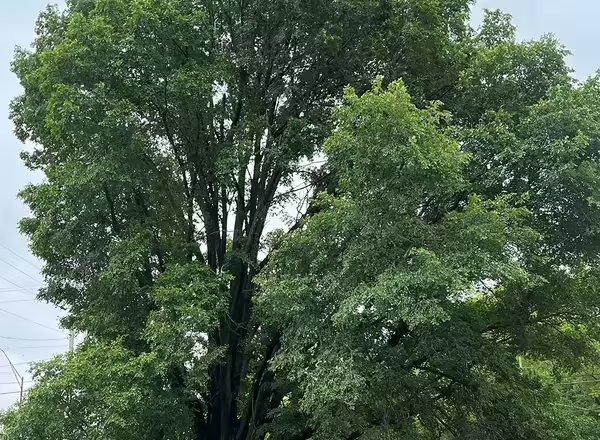
(Ulmus pumila)
A native of eastern Asia, Siberian elm was introduced to the U.S. in the 1860s for its hardiness, fast growth, and ability to grow in various moisture conditions. It is resistant to Dutch elm disease. It is sold commercially as a shelterbelt and windbreak tree. It is found throughout the U.S. and is generally no longer recommended for planting due to its invasiveness, brittle branches that can break easily, and susceptibility to pest problems, especially elm leaf beetles.
Size: 30-60 ft tall
Habit: Open rounded crown with slender, spreading branches.
What to look for:
- Siberian elm flowers are light green to reddish, lack petals and occur in small, compact, drooping clusters of two to five. Flowers appear between March and May, before leaves develop.
- Siberian elm fruit is called a samara. The samara is winged, round, and smooth and contains one seed. The fruit hangs in clusters and is spread by the wind.
Of interest:
Siberian elm grows well in disturbed areas. Its seed germination rate is high and seedlings establish quickly in sparsely vegetated areas.
When Siberian elm trees are cut, they can resprout from the stump and root
It is currently not regulated in the Midwest except in Wisconsin where its sale is prohibited.
photo credit: Dick Potter

(Amelanchier arborea)
This beautiful native is a favorite landscape tree having interest in all seasons with spring flowers, summer fruits, excellent fall color, and interesting bark. It is one of the first shrubs to flower in the spring.
Size: 15-25 ft tall
Habit: Rounded, multi-stemmed
What to look for:
- Pure white and borne in 2-4" long pendulous racemes in mid to late April, these extremely showy flowers only last 4 to 7 days.
- Favored by birds and other wildlife of all kinds, the reddish-purple fruit is a 1/4" - 1/3" edible pome that matures in June. It is a food source for the larvae of tiger butterflies and viceroys. Gypsy moth larvae also feed on it. The fruit is delicious, with a taste akin to those of blueberries. Can be used to make pies, jams, and preserves.
- In autumn, the colors are excellent, ranging from brilliant shades of yellow to orange and bronze-red.
- The trunk is interesting with a nice smooth gray, vertically striated bark.
Of interest:
- The wood is hard, fine-grained and used for tool handles.
- “Downy” serviceberry is from the grayish, fuzzy or downy emerging leaves,
- It acquired the common name serviceberry because it blooms as soon as the ground starts to thaw, which was when people were able to dig graves and bury their dead after the winter.
- It forms root suckers, and if they are allowed to grow, it will result in the plant growing as a shrub rather than a tree. Over time, the suckers will cause the plant to form a small colony.
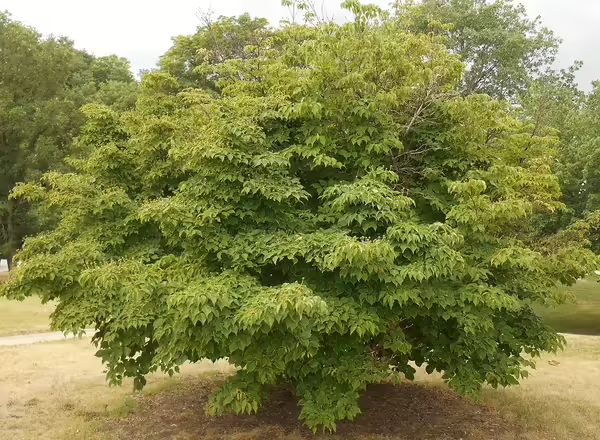
(Cornus kousa)
A beautiful flowering tree native to China, Korea, and Japan. Kousa dogwood was cultivated in the 1870s and is now widely used as an ornamental tree throughout the world. It has all-season appeal with its flowers, foliage, bark, and shape.
Size: 20-30 ft tall
Habit: Vase shaped in youth becoming rounded with age with horizontally stratified branching
What to look for:
- Showy white, four-petaled flowers appear in mid-June, about 2-3 weeks after native dogwoods, and may last up to 6 weeks.
- Held uniformly above the foliage, the flowers accentuate the horizontal branching pattern of the plant. The white bracts take on a pink blush as they age.
- The interesting fruits are raspberry-like in their appearance, pinkish-red and are 3/4" in diameter, ripening in August-September. The fruits are considered edible, but not very tasty.
- A subtle but ornamental feature, the patchy multicolored bark is a combination of gray, tan, brown, and green on older branches and trunks of about 4" in diameter and larger.
- The fall color is usually excellent, and varies from red to reddish-purple and occasionally yellowish- orange. It lasts 3-5 weeks.
Of interest:
- Cornus is from the word “conus” meaning horn, referring to the hard wood and Kousa is the Japanese word for this dogwood.
- There are 65 different species of dogwoods.
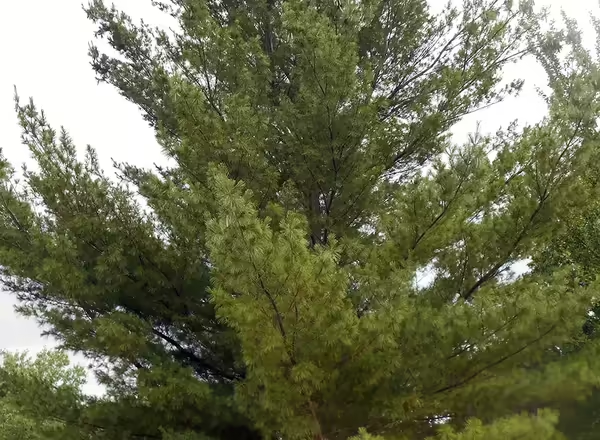
(Pinus strobus)
White pine is the state tree of Maine and Missouri. Growth is very rapid at first but slows down with age. Be sure to purchase only certified rust-resistant plants.
Size: 50-100' high
Habit: Symmetrically pyramidal in youth, developing a broad, open, and picturesque or irregular crown with age; lateral branches are horizontal or ascending and the lower branches are lost with age.
What to look for:
- Slender and soft to the touch, the 3-5" evergreen needles are borne in clusters of 5 needles. The needles last only 2-3 years and the 1/2" orange-brown leaf sheaths fall as the needles mature.
- Male flowers are small, oblong, yellowish-green, and clustered on the current season's growth; while female flowers (found on the same tree) are 1/4 - 1/2" long, reddish purple, and stalked.
- The 4-8" cylindric and pendulous cones are stalked and resinous. They are initially green, turning light brown as they mature, bearing thin spineless scales.
- Although this is an evergreen, considerable fall yellowing occurs as the 2-year-old needles yellow and drop.
Of interest:
- White Pine is used for construction, millwork, trim, and pulpwood.
- The seeds were introduced in England (where it is called Weymouth Pine) from Maine in 1605 by Captain George Weymouth of the British Navy.
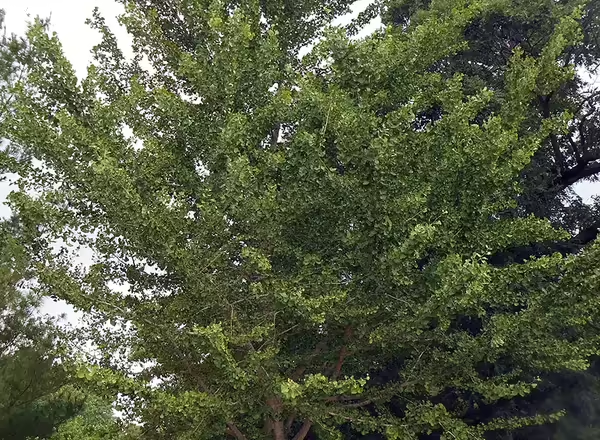
(Ginkgo biloba)
The ginkgo is a living fossil – over 200 million years old. It is a single species with no known living relatives. It disappeared from all over the world except in a small area in China, where it was discovered over 1000 years ago. It has been re-planted world-wide. It’s also known as the Maidenhair tree because its leaves resemble a maidenhair fern.
Size: 50'-80'
Habit: Pyramidal when young, becoming wide rounded-pyramidal with large coarse branches; unusual branch angles are common.
What to look for:
- Is a deciduous, dioecious tree - having both male and female trees
- Unique fan-shaped leaves
- Females produce nuts covered with a hard shell, which is covered with a fleshy yellow-orange fruit layer. This fruit layer smells terrible as it rots, and is toxic (except to dinosaurs).
- Excellent yellow fall color
Of Interest:
- Except for the smelly fruit, the ginkgo is considered a “perfect tree.” It is very adaptable and will tolerate salt and air pollution, a range of pH, sun, and soil conditions. It is free of insect and disease pests.
- It has survived atomic bombs, flooding, and fires. It is long-lived - the oldest known is 4000 yrs old in Lebang Village, China.
- The nuts are toxic if eaten raw, but are a delicacy in Asia when roasted.
- The nuts and leaves have medicinal value.
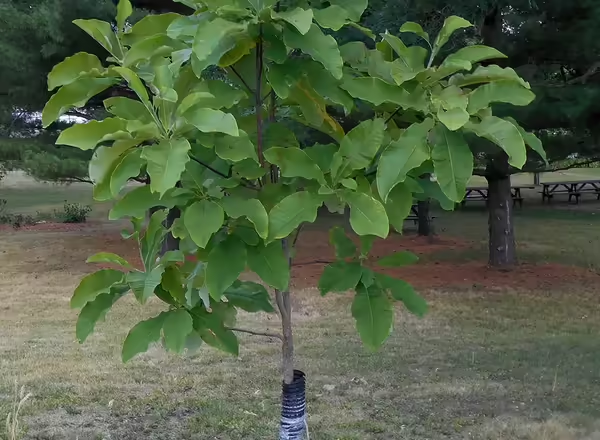
(Magnolia acuminata)
A large native tree with fairly large deciduous leaves and a pyramidal to rounded habit that is well suited to use as a shade tree in large areas. These trees cast dense shade and are beautifully symmetrical. The greenish-yellow flowers of this species are much less showy than those of other magnolias.
Size: 50-80 ft tall
Habit: Pyramidal in youth, becoming rounded to broad-rounded.
What to look for:
- Alternate, simple, and large, the 4-10" leaves are dark green above with a light green underside.
- Greenish-gray young stems turn reddish-brown as they mature. They are fragrant when scratched.
- Although interesting, the greenish-yellow flowers do not stand out from the surrounding foliage. They appear in late May to early June.
- Appearing for only a short time in October, the fruit is a 2-3" long aggregate of follicles in a cone shape that is green turning to red when young and matures to brown. Individual red-coated seeds are suspended on slender threads at maturity.
Of interest:
- It is named for the green, warty, cucumber-shaped fruits that first follow the flowers.
- The leaves have nice yellow-gold fall color.
- An interesting native species, it is probably best suited for planting in large parks, golf courses or large-scale landscapes because of its sheer size.
Photo Credits
Unless otherwise noted, all photos by Durnal-Corso, D. (2023, June 25). Taken at Moline Riverside Gardens.